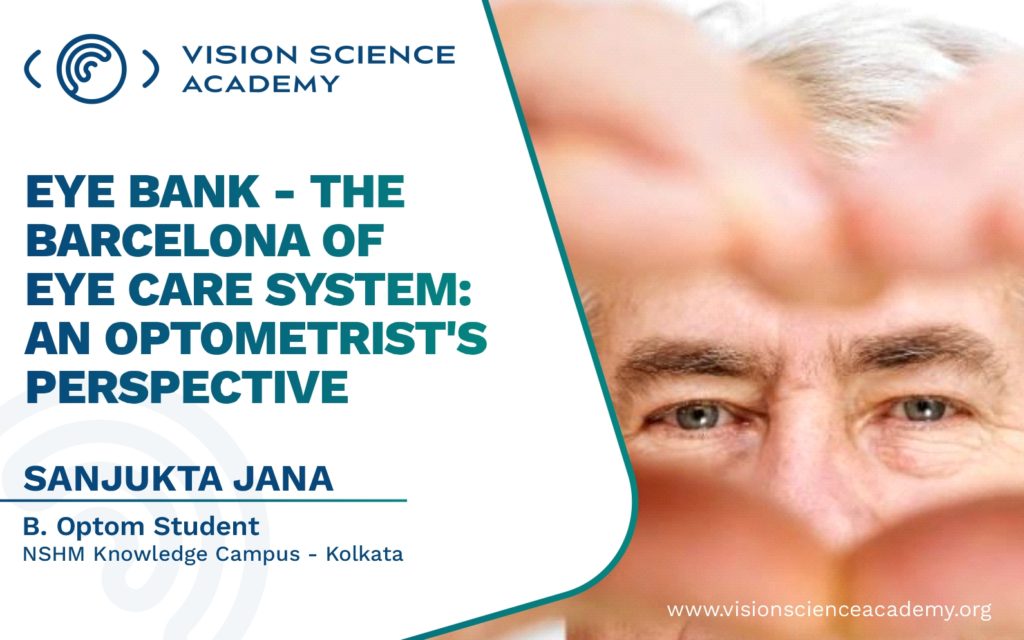Sanjukta Jana, B. Optom
Student, NSHM Knowledge Campus, Kolkata, India
Barcelona is the cosmopolitan capital of Spain famed because of its individuality. Similarly, an eye bank can be portrayed as the Barcelona of the eye care system for its wide range of features. Eye banks are relatively autonomous, voluntary and community-based, structured to meet the need for equitable distribution of harvested corneal tissue for human use and research. (1)
The cornea is the ‘window of the eye’ because it is transparent in nature. In case of any corneal disease the loss of its clarity results in loss of vision. After cataract and glaucoma, corneal blindness is the third leading cause of blindness. (2)
Figure 1: Pyramid bar diagram highlighting the most common corneal transplantation indications.
[Picture courtesy- This figure has been prepared by the author based on research paper evidence.]
Eye bank aims to objectify the trends in:
- Grief counselling, a legal procedure including proper documentation, rechecking through donor’s medical records to look for ocular and systemic contraindications is performed by optometrists.
- Tissue retrieval – Tissue can be retrieved for transplantation either by performing an enucleation, or in-situ corneoscleral excision by the ophthalmologists of our team. Mostly done within either six hours of death or within six to twelve hours of death.
- Donor viability evaluation includes a gross examination on a slit lamp biomicroscope. Specular microscopy is done to prove the presence of adequate endothelium. Corneal clarity is graded based on presence or absence of epithelium defects, edema, and scars. 2)
- Cornea preservation – The whole globe is stored in a sealed container at 4o C after applying topical antibiotics or povidone-iodine solution. A long-term organic culture system involves placing the corneoscleral button in a Petri dish at 34o C in 5 % CO2 in water-jacketed incubators. Corneas after excision can be stored in Mc Cary Kaufman medium (MK medium) for four days or in Optisol for ten days. (3)
- Awareness – Analysis shows an increase in public awareness programs on organ donation has resulted in actual conversion of NO to YES in case of eye donation. (4)
Table 1: The influencing factors in working procedure of eye banking system have been described below
| Factors influencing the working procedure of eye banking | Role of optometrists in overcoming obstacles and raising awareness | |
|---|---|---|
| Sars cov – 2 obstacles |
|
|
| Conversion by eye donation centre | Reasons of conversion
|
Reason of non-conversion
|
| Walk on part |
|
|
To keep scrolling through social media even after death, eye donation is the best way.
References:
- Dutta L. (2005) Modern Ophthalmology (3rd Ed.) (Vol 2). Jaypee Brothers Medical Publishing.
- Sharma, N., Arora, T., Singhal, D., Maharana, P. K., Garg, P., Nagpal, R., Murthy, S., Gunnam, S., Arora, A., Prajna, V., Rajaraman, R., Padmanabhan, P., Kumar, A., Kumar, R., Tomar, S., Thomas, A., Gyanchand, R., Arora, R., Biswas, B., & Basak, S. (2019). https://doi.org/10.4103/ijo.IJO_1551_18
- Community Eye Health. 2009 Dec; 22(71).
- Sharma, B., Shrivastava, U., Kumar, K., Baghel, R., Khan, F., & Kulkarni, S. (2017). Journal of clinical and diagnostic research: JCDR, 11(8), NC12–NC15. https://doi.org/10.7860/JCDR/2017/27287.10421
Image reference(s):
Figure 1: This figure has been created by author based on evidence from –
Gain P, Jullienne R, He Z, Aldossary M, Acquart S, Cognasse F, et al Global survey of corneal transplantation and eye banking JAMA Ophthalmol. 2016;134:167–73
Table reference(s):
Table 1: This table has been created by the author based on theories from – Dutta L. (2005) Modern Ophthalmology (3rd Ed.) (Vol 2). Jaypee Brothers Medical Publishing.
